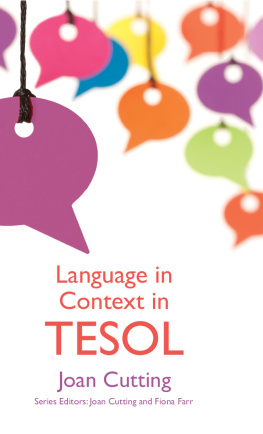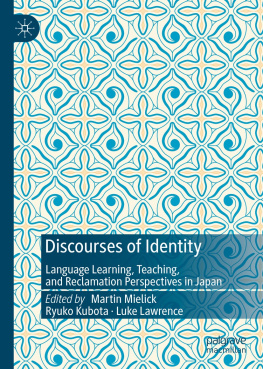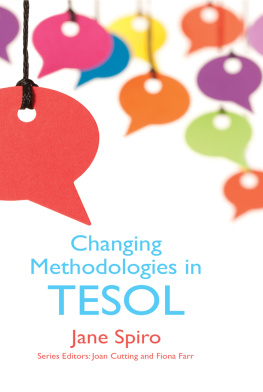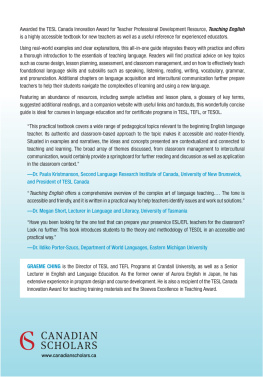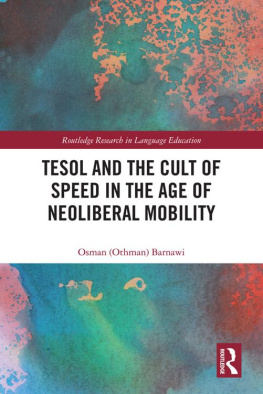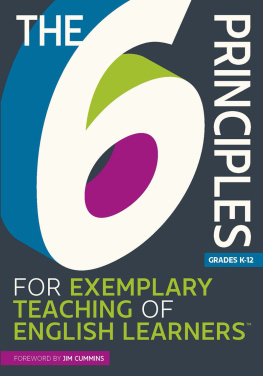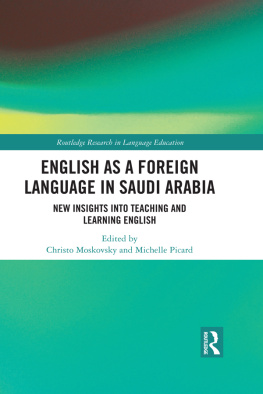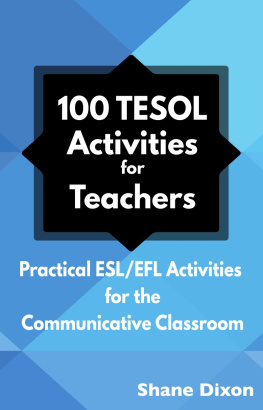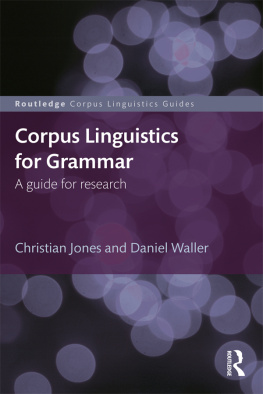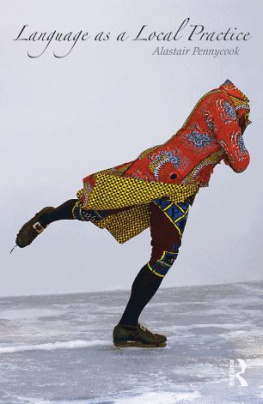Language in Context in TESOL
Language in Context in TESOL
Joan Cutting
EDINBURGH
University Press
Joan Cutting, 2015
the chapters their several authors, 2015
Edinburgh University Press Ltd
The Tun Holyrood Road, 12(2f) Jacksons Entry, Edinburgh EH8 8PJ
www.euppublishing.com
Typeset in 10/12 Minion by
Servis Filmsetting Ltd, Stockport, Cheshire,
and printed and bound in Great Britain by
CPI Group (UK) Ltd, Croydon CR0 4YY
A CIP record for this book is available from the British Library
ISBN 978 0 7486 4282 3 (hardback)
ISBN 978 0 7486 9927 8 (webready PDF)
ISBN 978 0 7486 4281 6 (paperback)
ISBN 978 0 7486 9928 5 (epub)
The right of Joan Cutting to be identified as Author of this work has been asserted in accordance with the Copyright, Designs and Patents Act 1988, and the Copyright and Related Rights Regulations 2003 (SI No. 2498).
CONTENTS
FIGURES AND TABLES
FIGURES
TABLES
ABBREVIATIONS
| ACE | Asian Corpus of English |
| AL | Applied Linguistics |
| BNC | British National Corpus |
| CA | Conversation Analysis |
| CANCODE | Cambridge and Nottingham Corpus of Discourse in English |
| CIC Cambridge | International Corpus |
| CL Corpus | Linguistics |
| CLC Cambridge | Learner Corpus |
| COCA | Corpus of Contemporary American English |
| CP | Cooperative Principle |
| CS | code-switching |
| DDL | data-driven learning |
| EAP | English for Academic Purposes |
| EIL | English as an International Language |
| ELF | English as a Lingua Franca |
| ELFA | English as a Lingua Franca in Academic Settings |
| ELT | English Language Teaching |
| ENL | English as a Native Language |
| ESL | English as a Second Language |
| ET | Exchange Theory |
| FTA | face-threatening act |
| GE | Global Englishes |
| ICE | International Corpus of English |
| ICLE | International Corpus of Learner English |
| KWIC | key words in context |
| MICASE | Michigan Corpus of Academic Spoken English |
| NES | native English speaker |
| NNES | non-native English speaker |
| SAT | Speech Act Theory |
| SCOTS | Scottish Corpus of Texts and Speech |
| SELF | Studying in English as a Lingua Franca |
| SLA | second language acquisition |
| VOICE | ViennaOxford International Corpus of English |
| WE | World Englishes |
TRANSCRIPTION SYMBOLS
| // | Interruption, e.g.
AHey, what are you do- //
B // Im just checking my emails
in which A is prevented from finishing her utterance by Bs words |
| = | Overlap, e.g.
AHey, what are you doing? =
B= Im just checking my emails
in which Bs first words occur simultaneously with As words but do not prevent A from finishing her utterance |
| (0.5) | Pause, expressed as number of seconds, e.g.
A Hey, what are you doing?
B Im just (2) checking my emails in which B hesitates for two seconds while he thinks or is distracted by actually reading his emails as he speaks |
| [laughs] | Non-verbal sounds or gestures, e.g.
A Hey, what are you doing? [snaps her fingers]
B Im just [sighs] checking my emails in which extraneous noises, meaningful or otherwise, are noted. |
ACKNOWLEDGEMENTS
Many thanks to my colleagues for our many explanations, discussions and rewritings to get these chapters into shape. I offer thanks to Aled Owen for his editorial comments aimed at increasing the accessibility of the text. I am most grateful to Fiona Farr, co-editor of the Edinburgh Textbooks in TESOL series, for her invaluable and insightful suggestions. Thanks to the series Editorial Board for extending their experience to the development of the series.
Joan Cutting
SERIES EDITORS PREFACE
Editors Joan Cutting, University of Edinburgh and Fiona Farr, University of Limerick
This series of textbooks addresses a range of topics taught within TESOL programmes around the world. Each volume is designed to match a taught core or option course (identified by a survey of TESOL programmes worldwide) and could be adopted as a prescribed text. Other series and books have been aimed at Applied Linguistics students or language teachers in general, but this aims more specifically at students of ELT (English Language Teaching the process of enabling the learning of English), with or without teaching experience.
The series is intended primarily for college and university students at third or fourth year undergraduate level, and graduates (pre-service or in-service) studying TESOL on Masters programmes and possibly some TESOL EdDs or structured PhDs, all of whom need an introduction to the topics for their taught courses. It is also very suitable for new professionals and people starting out on a PhD, who could use the volumes for self-study. The readership level is introductory and the tone and approach of the volumes will appeal to both undergraduates and postgraduates.
This series answers a need for volumes with a special focus on intercultural awareness. It is aimed at programmes in countries where English is not the mother tongue, and in English-speaking countries where the majority of students come from countries where English is not the mother tongue, typical of TESOL programmes in the UK and Ireland, Canada and the US, Australia and New Zealand. This means that it takes into account physical and economic conditions in ELT classrooms round the world and a variety of socio-educational backgrounds. Each volume contains a number of tasks which include examples from classrooms around the world, encourage comparisons across cultures and address issues that apply to each students home context. Closely related to the intercultural awareness focus is a minor theme that runs throughout the series, and that is language analysis and description, and its applications to ELT. Intercultural awareness is indeed a complex concept and we aim to address it in a number of different ways. Taking examples from different cultural contexts is one way of tackling the issue of intercultural awareness, but the volumes in the series also look at many other educationally relevant cultural dimensions such as sociolinguistic influences, gender issues, various learning traditions (e.g. collectivist vs individualistic), culturally determined language dimensions (e.g. politeness conventions).
TESOL students need theory clearly related to practice. This series is practical and is intended to be used in TESOL lectures and workshops, providing group tasks and independent activities. Students are invited to engage in critical thinking and to consider applications of concepts and issues to their own particular teaching contexts, adapting the tendencies and suggestions in the literature to their own countries educational requirements. Each volume contains practical tasks to carry out individually, in small groups or in plenary in the classroom, as well as suggestions for practical tasks for the students to use in their own classrooms. All the concepts and issue encountered here will be translatable into the ELT classroom. It is hoped that this series will contribute to your improvement as a teacher.

